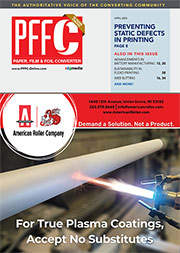Featured Stories
-
Nordson Divisions Collaborate to Achieve Unprecedented Flat Profile Time
Nordson Measurement & Control Solutions (a division of Nordson Corporation) is a global leading provider of gauging systems for the film... -
Preventing Static Defects in Digital Printing
Digital printing has revolutionized document creation. -
Choosing the Right Flexible Packaging Pouching Supplier
Wish you had more production capability to fulfill pouching jobs or maybe you are looking for a backup when your equipment goes down?
News | New Products
-
FLAG Announces April Lunch & Learn Event: Variable Data Printing in Labels & Preparing for the Sunrise 2027
Flexo Label Advantage Group LLC (FLAG) announced its upcoming April 2025 Lunch & Learn, taking place Thursday, April 17 at 2:00 PM EST.
-
CT Manufacturer Leads Global Green Packaging Industry
Strong, Sustainable Products Protect Human Lives And the Environment From Toxic Lithium Battery Fires
-
Rolling Start: Beontag and Kumho Tire Announce Partnership to Produce RFID-enabled Tires for Consumer, Commercial Vehicles
Beontag, one of the world’s largest manufacturers of self-adhesives and smart tags such as RFID
-
Unlocking Growth and Sustainability: How Packaging Powers Circularity for Consumer Packaged Goods Companies
Original research in a new white paper from Avery Dennison explores how innovative pressure-sensitive labels help enable packaging circularity throughout the value chain
-
Avery Dennison Names Senior Vice President and General Manager for Materials Group North America
Avery Dennison has named Anil Sharma as senior vice president and general manager for Materials Group, North America.
-
Esko – Mark Andy Innovation Day
How to optimize and increase label production efficiency
-
Now among the top 5 percent in terms of sustainability: Gold Medal for HERMA from EcoVadis for First Time
Following two silver medals in previous years, HERMA was able to achieve a gold medal for the first time in the EcoVadis sustainability audit.
Expert Advice
Workhorse Winders Do More Than Ever Before
- Published: December 01, 2001, By Claudia Hine, Senior Editor
Winding technology has gone way beyond what it was in the '90s, says Bruce Butler, VP of sales at Independent Machine Co., Fairfield, NJ. “The entire system is just way more sophisticated this year than it was even two years ago.”
The most significant changes include new control systems that use servo drives and PLC units as a means of controlling speed and machine sequencing functions, explains Don Rush, national sales manager at Elsner Engineering Works, Hanover, PA. “The ease of making adjustments using the new controls really makes the converter's life easier, as does the ability to store the memory of a particular run for a particular product and recall it at a later date for a repeat performance.”
“Everything is electronic and much more quantifiable,” adds Butler. Data acquisition capabilities allow operators to store speed and tension parameters for a particular job. “It takes the art out of the process. You store the recipes and then you get consistency time after time for that particular product.”
More sophisticated drive systems also mean the tension control is much better, he adds.
The desire for better core starts is increasing because products are getting more expensive, so waste reduction is a big factor, says Rich McCarthy, VP at New Era Converting Machinery, Paterson, NJ. “Today there's a greater variety of transfer technologies and cut types. Now it's common to use shear cutoffs, traversing knife cutoffs, and enveloping cutoff systems. There are various technologies available for no fold-over and no tape transfers. Some of these technologies have been around for some time, but they're being applied more often and at higher speeds. Converters want to handle difficult materials more automatically and at higher speeds.”
When writing specs for new equipment, McCarthy recommends converters consider what materials they might run in the future, because the ability to handle other materials can be built into a machine from the start, or the ability to modify it in the future can be built in. “If you've got a product that doesn't need a lay-on roll, and you build a machine without it or without provisions to add one, you might be cutting off your future,” he warns. “You can buy a machine that does gap winding, but you design it so it can do gap winding and pack winding.”
Butler cautions, however, converters must work with the OEM when writing specs. Otherwise, he says, “When you're trying to build a machine to do everything, you have to make it so generic it's not going to do anything great.”
For winding material that's subject to wrinkling, McCarthy says constant geometry winding really minimizes or eliminates the rewinding challenge of wrinkle formation just prior to the transfer. “Constant geometry means there are two sets of pack or gap rolls, one dedicated to each winding position, and they rotate with the turret,” he explains. “That means that the geometry of the web path leading to the winding roll stays constant through the entire cycle and doesn't get lost during the transfer. It gives you a better roll.”
Down the road, Rush predicts, winder manufacturers will improve their current lines even more, offering equipment with controls that are more operator friendly than they are today and that run at higher speeds than currently available.
That workhorse winder has become a thoroughbred.




















